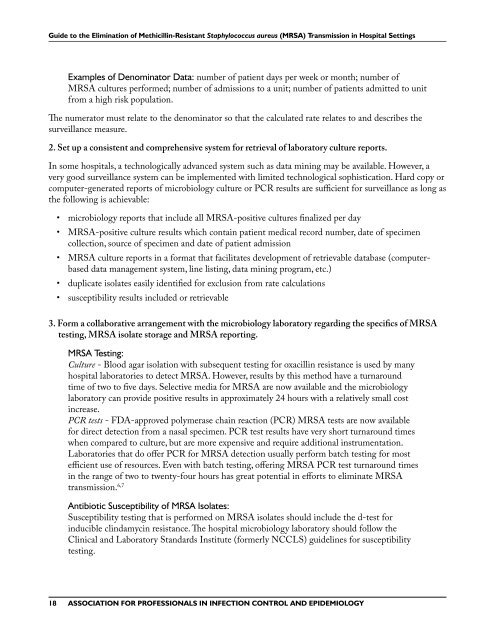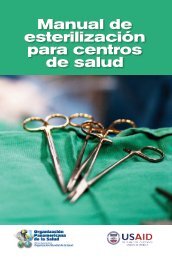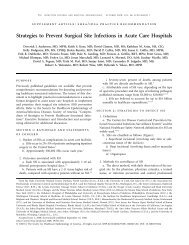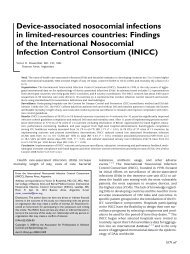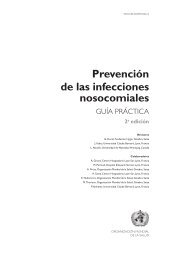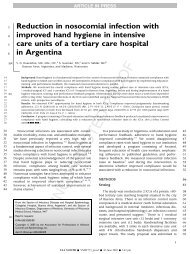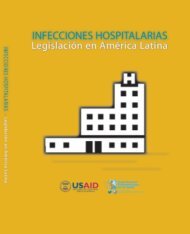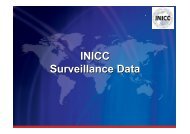APIC MRSA Elimination Guideline
APIC MRSA Elimination Guideline
APIC MRSA Elimination Guideline
You also want an ePaper? Increase the reach of your titles
YUMPU automatically turns print PDFs into web optimized ePapers that Google loves.
Guide to the <strong>Elimination</strong> of Methicillin-Resistant Staphylococcus aureus (<strong>MRSA</strong>) Transmission in Hospital SettingsExamples of Denominator Data: number of patient days per week or month; number of<strong>MRSA</strong> cultures performed; number of admissions to a unit; number of patients admitted to unitfrom a high risk population.The numerator must relate to the denominator so that the calculated rate relates to and describes thesurveillance measure.2. Set up a consistent and comprehensive system for retrieval of laboratory culture reports.In some hospitals, a technologically advanced system such as data mining may be available. However, avery good surveillance system can be implemented with limited technological sophistication. Hard copy orcomputer-generated reports of microbiology culture or PCR results are sufficient for surveillance as long asthe following is achievable:• microbiology reports that include all <strong>MRSA</strong>-positive cultures finalized per day• <strong>MRSA</strong>-positive culture results which contain patient medical record number, date of specimencollection, source of specimen and date of patient admission• <strong>MRSA</strong> culture reports in a format that facilitates development of retrievable database (computerbaseddata management system, line listing, data mining program, etc.)• duplicate isolates easily identified for exclusion from rate calculations• susceptibility results included or retrievable3. Form a collaborative arrangement with the microbiology laboratory regarding the specifics of <strong>MRSA</strong>testing, <strong>MRSA</strong> isolate storage and <strong>MRSA</strong> reporting.<strong>MRSA</strong> Testing:Culture - Blood agar isolation with subsequent testing for oxacillin resistance is used by manyhospital laboratories to detect <strong>MRSA</strong>. However, results by this method have a turnaroundtime of two to five days. Selective media for <strong>MRSA</strong> are now available and the microbiologylaboratory can provide positive results in approximately 24 hours with a relatively small costincrease.PCR tests - FDA-approved polymerase chain reaction (PCR) <strong>MRSA</strong> tests are now availablefor direct detection from a nasal specimen. PCR test results have very short turnaround timeswhen compared to culture, but are more expensive and require additional instrumentation.Laboratories that do offer PCR for <strong>MRSA</strong> detection usually perform batch testing for mostefficient use of resources. Even with batch testing, offering <strong>MRSA</strong> PCR test turnaround timesin the range of two to twenty-four hours has great potential in efforts to eliminate <strong>MRSA</strong>transmission. 6,7Antibiotic Susceptibility of <strong>MRSA</strong> Isolates:Susceptibility testing that is performed on <strong>MRSA</strong> isolates should include the d-test forinducible clindamycin resistance. The hospital microbiology laboratory should follow theClinical and Laboratory Standards Institute (formerly NCCLS) guidelines for susceptibilitytesting.18ASSOCIATION FOR PROFESSIONALS IN INFECTION CONTROL AND EPIDEMIOLOGY


